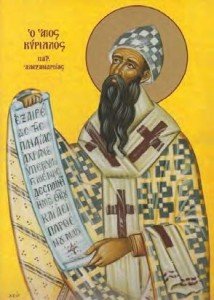In this article I have presently been dealing with St. Cyril of Alexandria’s ideas about the resurrection of the human body. St. Cyril stated that the Lord’s Resurrection must have also included His body since its very purpose was to release human flesh from the power of both death and corruption. Following the schema typical of the Eastern Church, Cyril says that “the power of death extended only over the flesh,” that is, over the humanity but not the divinity of Christ. For death and corruption could not be said to have any dominion over the Person of Christ, the divine Logos, who is by His very nature Life itself. Cyril describes the mystery in this manner:
If His dead body had not risen, what kind of death was vanquished, and how was the power of corruption rendered powerless? Not by the death of one of the rational creatures, by a soul, or by an angel, nor even by that of the Word of God Himself. Since, therefore, the power of death extends only over that which is by nature corruptible, it is with respect to this [the body] that the power of the Resurrection should reasonably be understood.
Hopefully this makes some sense. Christ rose bodily from the dead in order to crush death and corruption in human nature, which was the goal of His incarnation. The resurrection of the human flesh of Christ – soul and body – is thus an absolute prerequisite for the salvation of man.
That is what salvation means in Eastern thought, namely that neither death nor corruption have any control over human nature. In Cyril physical death is understood as “the exodus of the human soul from the body”, and as a result of this exodus of the soul, it is the body which suffers corruption. It is not the soul but the body which, being of its nature corruptible, is in need of being rendered and made incorruptible. Thus by the Death and Resurrection of the body of Christ, the power of corruption was “rendered powerless.” Hence, the Holy Body of Christ, which the Apostle Thomas was allowed to touch, bears witness to the future resurrection of our own bodies in incorruption.
The glory of the body of Christ, as shown at His Transfiguration, revealed to us that Life, because it is a sharing in God’s own life, is free from corruption and death. Since Christ rose bodily from the grave, death has no sting!

